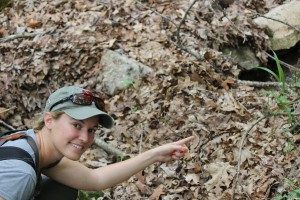Julianna Jenkins, University of Missouri – Songbirds Face Risks Leaving The Nest
 Not all birds face the same risks when leaving the nest.
Not all birds face the same risks when leaving the nest.
Julianna Jenkins, post-doctoral research fellow at the University of Missouri, explores the survival rates of two types of birds as they venture on their own.
My dissertation work focused on understanding the transition between the nesting and postfledging life stages of Neotropical migrant songbirds on the breeding grounds. I worked with two interior forest nesting migrant focal species: the Ovenbird (Seiurus aurocapilla) and the Acadian Flycatcher (Empidonax virescens) in the fragmented forests of Central Missouri.
From 2010-11 I worked for the Wisconsin DNR as a Research technician for wetland biologist, Ron Gatti in Spring 2010, and as Assistant Upland Research Biologist under Dr. Scott Hull. Research projects included Greater Prairie Chicken monitoring, Sharp-tail Grouse monitoring and radio telemetry, grassland songbird nesting surveys, Blue-wing teal nesting surveys, and statewide pheasant roadside surveys. Additionally I was coauthor and support staff for the inter-agency publication, “Wisconsin Sustainable Planting and Harvest Guidelines for Nonforest Biomass”.
In 2009 I interned with the International Crane Foundation (ICF), field ecology department. I was a field technician on sandhill crane research projects investigating juvenile crane habitat use and sandhill crane crop predation sponsored by ICF field ecology director, Jeb Barzen and crane research manager, Anne Lacy. I participated in extensive sandhill crane capture efforts in Wisconsin and Ontario, Canada that incorporated blood collection, morphologic measurements, and banding.
In the fall of 2008 I was a biologist intern at the Keauhou Hawaiian Bird Breeding Center in Volcano, Hawaii. I participated in daily care of endangered Hawaiian breeding birds: diet prep, aviary maintenance, behavioral enrichment, health checks, and daily behavioral observations.
During the summer of 2008 I worked for the Maria Mitchell Natural Science Museum, Nantucket Island, MA where I participated in research with Dr. Bob Kennedy including: Barn Owl and Osprey banding and population monitoring, and Bay Scallop monitoring. I also participated in MA Audubon color band re-sighting and regional survey of common and roseate tern populations.
As an undergraduate at UW-Madison, I wrote and received funding ($5000) to conduct a summer research project in Costa Rica investigating the Spatial Ecology of the Margay, Leopardus wiedii in a Costa Rican Cacao Agro forest and participated in population monitoring of the Scarlet Macaw with Chris Vaughan, PhD.
Songbirds Face Risks Leaving The Nest
Baby songbirds in the nest face naturally tough odds; unable to fly, they are easy prey for cats, snakes, and even other birds.
However, the perils don’t end when young birds venture from the nest. Our research focused on the risks baby migratory songbirds face in and out of the nest and our findings may have important implications for migratory songbird conservation.
Once out of the nest, fledglings need to gain the skills to survive on their own. It is during this time that the majority of mortalities occur.
You can think of young fledglings as teenagers getting ready to leave the house. They still depend on their parents for a lot of things and may have pretty poor judgement. While scientists know it’s a dangerous time for baby birds, they don’t know what may be affecting mortality or if risks post-fledging are similarly affected by habitat as compared to the nesting period.
So, we documented nesting habitat and survival and fitted baby Ovenbirds and Acadian Flycatchers with lightweight, temporary radio transmitters. We then followed them daily for four weeks using handheld receivers. We recorded the young birds’ behaviors and survival as well as characteristics of their habitat.
Ovenbirds and Acadian flycatchers had similar nesting success but experienced very different mortality rates post-fledging. Even though they shared the same area of habitat, around 90 percent of juvenile Acadian flycatchers and about 50 percent of Ovenbirds survived these first few weeks out of the nest. These results tell us that we cannot assume that species occupying similar nesting habitats will have similar risks after leaving the nest.
The study also is important because it sheds new light on factors that impact the survival of songbirds during a critical period in their lives. The more we know, the better equipped we will be to provide them suitable habitats.


